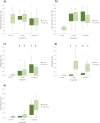Ant responses in a lycaenid-ant symbiosis are not facilitated by cuticular compounds alone
- PMID: 40337257
- PMCID: PMC12056671
- DOI: 10.1098/rsos.241320
Ant responses in a lycaenid-ant symbiosis are not facilitated by cuticular compounds alone
Abstract
Initiating partnerships in protective symbioses can be asymmetrical if there is a risk of attack from their symbionts. Myrmecophiles may encounter chemically mediated recognition systems that allow the host ants to distinguish nestmates from natural enemies, including non-nestmate conspecifics. The immature stages of the lycaenid butterfly Jalmenus evagoras form an obligate symbiosis with workers of Iridomyrmex mayri that protect them against natural enemies. However, the first instar larvae cannot anticipate this colony-specific chemical recognition system, since they are unlikely to encounter workers from the same colony that tended their mother. We show experimentally that workers of I. mayri can use chemical signals alone to distinguish between conspecifics and the larvae of J. evagoras; between nestmate and non-nestmate conspecifics and between larvae tended by nestmate and non-nestmate conspecifics. Nevertheless, we also show experimentally that while workers paid more attention to fourth than second instar larvae, they did not respond more aggressively to larvae that had been tended by non-nestmate versus nestmate workers. These data suggest that workers pay attention to other signals, perhaps via tactile, visual or vibratory sensory modalities, thereby allowing the butterfly myrmecophiles to mitigate the risks associated with the chemically mediated colony-specific recognition systems of their ant hosts.
Keywords: Lycaenidae; ants; colony recognition; cooperation; myrmecophily.
© 2025 The Author(s).
Conflict of interest statement
We declare we have no competing interests.
Figures


Similar articles
-
Eavesdropping on cooperative communication within an ant-butterfly mutualism.Naturwissenschaften. 2016 Oct;103(9-10):84. doi: 10.1007/s00114-016-1409-5. Epub 2016 Sep 27. Naturwissenschaften. 2016. PMID: 27679457
-
Local distribution of the lycaenid butterfly, Jalmenus evagoras, in response to host ants and plants.Oecologia. 1988 Aug;76(3):416-422. doi: 10.1007/BF00377037. Oecologia. 1988. PMID: 28312022
-
What are the Mechanisms Behind a Parasite-Induced Decline in Nestmate Recognition in Ants?J Chem Ecol. 2017 Sep;43(9):869-880. doi: 10.1007/s10886-017-0880-6. Epub 2017 Aug 25. J Chem Ecol. 2017. PMID: 28842787
-
Chemical disguise of myrmecophilous cockroaches and its implications for understanding nestmate recognition mechanisms in leaf-cutting ants.BMC Ecol. 2016 Aug 5;16:35. doi: 10.1186/s12898-016-0089-5. BMC Ecol. 2016. PMID: 27495227 Free PMC article.
-
The ecology and evolution of ant association in the Lycaenidae (Lepidoptera).Annu Rev Entomol. 2002;47:733-71. doi: 10.1146/annurev.ento.47.091201.145257. Annu Rev Entomol. 2002. PMID: 11729090 Review.
References
-
- Elgar MA, Riehl C. 2021. Editorial: mechanisms of communication and recognition in social evolution. Front. Ecol. Evol. 8, 625831. (10.3389/fevo.2020.625831) - DOI
-
- Thomas ML, Parry LJ, Allan RA, Elgar MA. 1999. Geographic affinity, cuticular hydrocarbons and colony recognition in the Australian meat ant Iridomyrmex purpureus. Naturwissenchaften 86, 87–92. (10.1007/s001140050578) - DOI
-
- Sturgis SJ, Gordon DM. 2012. Nestmate recognition in ants (Hymenoptera: Formicidae): a review. Myrmecol. News 16, 101–110. (10.25849/myrmecol.news_011:173) - DOI
LinkOut - more resources
Full Text Sources

